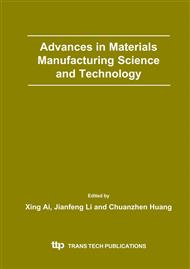p.414
p.418
p.422
p.426
p.431
p.438
p.443
p.448
p.453
Wear of High Speed Steel Bi-Metal Bandsaw Blade when Cutting AvestaPolarit 17-7 Stainless Steel in the As-Cast State
Abstract:
This paper reports experimental data on the wear of high-speed steel bimetal bandsaw blades cutting austenitic 17-7 stainless steel bars. Several different methods of assessing the wear modes and mechanisms are evaluated; Cutting and thrust force components, Set width, Kerf width, “Out-of-square” cutting, Wear modes and mechanisms and Chip characteristics. The wear mode established in the current work when bandsawing austenitic stainless steel with a bimetal blade is flank and corner wear together with formation of a cutting edge radius. The cutting edge radius increases as the wear progresses, reaching 25-50 mm after 300 cut sections. The established wear mechanism for the initial stages of wear is mild adhesive wear of the flank surface together with built-up edge formation and break-down. As the wear reaches steady-state the mechanism is adhesive wear of the flank surface with tempering/softening of high-speed steel layers. When the wear reached the steady-state region the level of thrust and cutting force were equal and relatively high. The kerf width appears to be less than the total set width of the blade, meaning that there is compression of the set teeth as they pass through the kerf. There is segmented chip formation with an increasing amount of vibration as the teeth wear, probably due to the increasing size of cutting edge radius. This work should be of great interest to the tool designer and user associated with bandsaws.
Info:
Periodical:
Pages:
431-437
Citation:
Online since:
December 2004
Authors:
Keywords:
Price:
Сopyright:
© 2004 Trans Tech Publications Ltd. All Rights Reserved
Share:
Citation:


